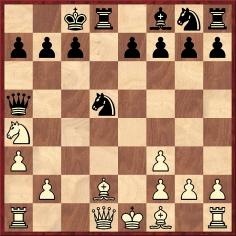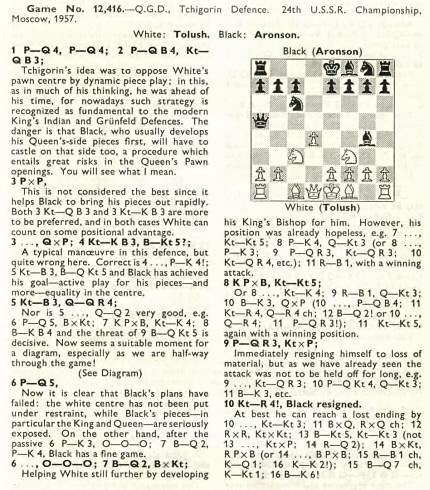
Edward Winter
Pablo Morán (Gijón, Spain) draws our attention to the game Tolush-Aronson, USSR Championship, 1957: 1 d4 d5 2 c4 Nc6 3 cxd5 Qxd5 4 Nf3 Bg4 5 Nc3 Qa5 6 d5 O-O-O 7 Bd2 Bxf3 8 exf3 Nb4 9 a3 Nxd5 10 Na4 Resigns.

In the April 1987 CHESS (page 465) the identical moves were given as having been played in a game Alekhine-Nenarokov, Moscow, 1907. Our correspondent says that he has never seen this game ascribed to Alekhine, and asks for details.
Ed Tassinari (Scarsdale, NY, USA) has found that the game was given as having been played between Alekhine and Nenarokov on page 257 of the September 1959 Chess Review. In a letter to the editor, ‘Grigory Bogunovich, Pittsburgh, Penna.’ wrote:
‘May I present the following game for publication? This game, played in 1907 when Alekhine was only 15, greatly surprised Nenarokov, who had beaten Alekhine decisively before.
Before the Revolution, I knew Nenarokov personally and he often remarked that Alekhine had the true Aryan spirit that goes with chess, coupled with an almost overpowering Zwigwille.
The game I send you has never before been published to my knowledge. It was an offhand game, played in the Moscow Chess Club, was witnessed by only four people, including myself.
It was a scene to behold: Alekhine smoking that devilish weed, makhorka; Nenarokov, lifting his withered face up occasionally to study his opponent or to sip his mineral water. At the end of the game, Nenarokov, as was his custom, said nothing and left the room while Alekhine spent the next three-quarters of an hour engaged in happy analysis with us!’
The game is then given, ‘A.A.Alekhine v L.Nenarokov’. There are two notes. After White’s sixth move: ‘Alekhine made this move almost immediately. Plainly, Black’s game is lost.’ Then there is the following after Black resigned at move ten:
‘At best, Black can reach a lost ending with 10 ... N-N3 11 BxQ RxQ+ 12 RxR NxN 13 B-N5 N-N3 (not 13 ... NxP because of 14 R-Q2) 14 BxN RPxB (or 14 ... BPxB 15 R-B1+ K-Ql 16 K-K2!) 15 B-Q7+ K-N1 16 B-K8! (analysis mine).’
The Chess Review contributor signs off with the words: ‘I am looking forward to the publication of this miniature.’
We do not believe a word of it. Firstly, the prose introduction contains too many incongruities. The handily anachronistic reference to ‘Aryan spirit’; that peculiar Zwigwille; would a boy of barely 15 have smoked in a public Moscow club room?; did Nenarokov really have a withered face when he was well under 30?; and if the contributor knew Vladimir Ivanovich Nenarokov personally, why did he give the initial of his forename as L.?
It is the second annotation to the game-score that convinces us that ‘Bogunovich’ was perpetrating a hoax. The identical Tolush-Aronson game, played in 1957, was published in the BCM of June 1959 (pages 168-169), in an article by P.H. Clarke entitled ‘Soviet Miniatures’. There are detailed annotations (subsequently re-used on pages 48-49 of the same author’s 100 Soviet Chess Miniatures), and the final one, explaining why Black resigned, reads:
‘At best he can reach a lost ending by 10...Kt-Kt3 11 BxQ RxQch 12 RxR KtxKt 13 B-Kt5 Kt-Kt3 (not 13...KtxP 14 R-Q2) 14 BxKt RPxB (or 14...BPxB 15 R-B1ch K-Ql 16 K-K2!) 15 B-Q7ch K-Kt1 16 B-K6!’
Apart from 16 B-K6/16 B-K8, the entire sequence of analysis is the same. ‘Bogunovich’ published it as his own only a couple of months after it had appeared in the BCM.

Chess Review, September
1959, page 257

BCM, June 1959, page 169
From page 127 of Winning Quickly at Chess by I. Neishtadt (London, 1997), after Tolush v Aronson, Moscow, 1957 has been given:
‘In 1967 it was reported in the Latvian magazine Shakhmaty that the score of a game won in 1907 by the young Alekhine against the Russian master Nenarokov had been discovered in the archives of a chess enthusiast. The game repeats move for move the above USSR Championship miniature.’
Over 20 years ago we published what may be regarded as overwhelming evidence that the 1907 claim was a fabrication.
(6354)
To the Archives for other feature articles.
Copyright: Edward Winter. All rights reserved.